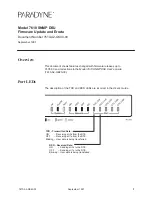
Behind Refrigerator
Under Refrigerator
Care should be taken in moving your refrigerator away from the wall.
All types of floor coverings can be damaged, particularly cushioned
coverings and those with embossed surfaces. Pull the refrigerator
straight out and return it to position by pushing it straight in. Moving
your refrigerator in a side direction may result in damage to your floor
covering or refrigerator.
When pushing the refrigerator back, make sure you don’t roll over the
power cord or icemaker supply line (on some models).
For most efficient operation,
you need to keep the area under the
refrigerator clean. Remove the base
grille and either sweep away or
vacuum up dust that is readily
accessible. For best results, use a
brush specially designed for this
purpose. It is available at most
appliance parts stores. This easy
cleaning operation should be done
at least once a year.
(continued next page)
Clean the condenser coils
at least once a year.
CARE AND CLEANING
Cleaning—Outside
The water and ice dispenser spill shelf (on some models) should
be wiped dry immediately to prevent spotting. Water left on the shelf
may leave deposits that you can remove by soaking with undiluted
vinegar. You can also use a paste of non-precipitating water softener
(such as Calgon brand) and water, or 1 teaspoon (5 ml) of citric acid
powder per pint (500 ml) of hot tap water. Soak until the deposit
disappears or becomes loose enough to rinse away. Usually 30
minutes soaking time is adequate. Avoid using wax on the spill
shelf and trim.
The dispenser pad can be cleaned by using a warm water and baking
soda solution—about a tablespoon (15 ml) of baking soda to a quart
(1 L) of water. Rinse thoroughly with water and wipe dry.
The door handles and trim (on some models) can be cleaned with a
cloth dampened with a solution of mild liquid dishwashing detergent and
water. Dry with a soft cloth. Don’t use wax on the door handles and trim.
The soft door handles (on some models) are easy to keep clean
if they are waxed every few months. Use a household wax such as
Pledge brand or Jubilee brand to coat the handles. Soil will then
easily wash off with a dish detergent and water or a non-abrasive
all-purpose cleaner.
Keep the finish clean. Wipe with a clean cloth lightly dampened with
kitchen appliance wax or mild liquid dishwashing detergent. Dry and
polish with a clean, soft cloth. Do not wipe the refrigerator with a
soiled dishwashing cloth or wet towel. These may leave a residue that
can erode the paint. Do not use scouring pads, powdered cleaners,
bleach or cleaners containing bleach because these products can
scratch and weaken the paint finish.
Protect the paint finish. The finish on the outside of the refrigerator
is a high quality, baked-on paint finish. With proper care, it will stay
new-looking and rust-free for years. Apply a coat of kitchen/appliance
wax when the refrigerator is new and then at least twice a year.
Appliance Polish Wax & Cleaner is available from Service and
Parts Centers.
Shelves
Car
e and Cleaning
Cleaning—Inside
Inside the fresh food and freezer compartments should be cleaned
at least once a year. Unplug the refrigerator before cleaning. If this is
not practical, wring excess moisture out of sponge or cloth when
cleaning around switches, lights or controls.
Use warm water and baking soda solution—about a tablespoon
(15 ml) of baking soda to a quart (1 L) of water. This both cleans and
neutralizes odors. Rinse thoroughly with water and wipe dry.
Other parts of the refrigerator—including door gaskets, meat and
vegetable drawers, ice storage bin and all plastic parts—can be
cleaned the same way. After cleaning door gaskets, apply a thin layer
of petroleum jelly to the door gaskets at the hinge side. This helps
keep the gaskets from sticking and bending out of shape. Do not use
cleansing powders or other abrasive cleaners.
Avoid cleaning cold glass shelves with hot water because the extreme
temperature difference may cause them to break.
To help prevent odors, leave an open box of baking soda in the
rear of the refrigerator, on the top shelf. Change the box every 3
months. An open box of baking soda in the freezer will absorb stale
freezer odors.
Quick Serve dishes and lids can be cleaned in an automatic
dishwasher or by hand with liquid dishwashing detergent and water.
You can remove stains by soaking them in a bleach and water solution
using one part chlorine bleach to three parts water. (Stubborn stains
may require soaking.) Use a plastic scouring pad to remove burned-on
soil. Do not use cleansing powders or other abrasive cleaners.
Drain opening in freezer compartment.
During yearly cleaning, remove bottom freezer
basket and flush a solution of baking soda—
1 teaspoon (5 ml) and 2 cups (500 ml) of hot
(not boiling) water—through the drain line with
the help of a meat baster. This will help eliminate
odor and reduce the likelihood of a clogged drain
line. If drain becomes clogged, use a meat baster
and baking-soda-and-water solution to force the
clog through the drain line.
Do not wash any plastic parts from your refrigerator in
your automatic dishwasher.
11












































